1/48 Roden Fokker D.VIIf, Ltn zur See Gotthard Sachsenberg
In the fall of 1916, in answer to air raids conducted over the Flanders front by the Royal Naval Air Service, the German Navy combined two Kampfeinsizter Kommandos into Marine-Flieger Abteilung II, based at Neumuenster. The unit was renamed the Marine Feld Jasta in January 1917, under the command of Leutnant zur See Gotthard Sachsenberg. By October 1917, Marine Jagdgruppe Flandern was formed from MFJ I and MFJ II; these were joined by MFJ III in June 1918 and MFJ IV that September, when the unit became the Marine-Geschwader Flandern. Throughout this organizational growth, Sachsenberg was chosen top commander, and he was considered “The Navy's Richtofen.”
Born in 1891, Gotthard Sachsenberg joined the Navy in 1912, and became an aerial observer in 1915. Trained as a pilot in 1916, Sachsenberg first flew Fokker Eindekkers. Following his appointment to command MFJ I, Sachsenberg scored his first victories - a Belgian Farman and an R.N.A.S. Sopwith “Strutter” - on May 1. By August, with a score of six, Sachsenberg was awarded the Hohenzollern Cross. A year later his score was 15.
The Marine-Fliegern first received the Fokker D.VII in mid-June 1918. Sachsenberg's airplane was a D.VIIf, though he had it re-engined with the high-compression Mercedes D.IIIau, for reasons unknown. By the middle of July the Jagdgruppe Flandern was completely re-equipped with D.VIIs, which were immediately identifiable to their opponents because of their yellow noses and tails. Sachsenberg's was even more identifiable with its upper wing painted yellow and the fuselage repainted yellow with a black diamond checkerboard, making it one of the most colorful D.VIIs flown by any German pilot.
Many of the air combats Sachsenberg participated in were over the North Sea, as was the battle on August 12, 1918 - a week after Sachsenberg had been awarded the Pour le Merite - when he and his pilots encountered D.H.9s of 218 Squadron RAF, escorted by Camels of the 148th Pursuit Squadron, U.S.A.S. Sachsenberg scored two of the seven aircraft shot down, a Camel flown by 1st Lt. R.D. Gracie which Sachsenberg shot to pieces at low altitude, and one of the D.H.9s, which took his score to 21. During the three months of battle left, Sacsenberg continued to score, bringing his final tally to 31.
Following the end of the war, Sachsenberg went on to organize the Freikorps Sachsenberg to fly and fight against the Bolsheviks in Latvia, Estonia and Lithuania during 1919-20. Accompanied by fellow Marine Flieger ace Theo Osterkamp and Army ace Josef Jacobs, Freikorps Sachsenberg was instrumental in providing air cover to the anti-communist forces in the Baltic States in their struggle for independence against the Red Army. Following his return to Germany, Sachsenberg took a position with Junkers and ended up in the upper ranks of management.
During the Second World War, Sachsenberg's cousin, Heino Sachsenberg, became a 104-victory experte on the Eastern Front with JG 52. Heino demonstrated an affinity for flying garishly-marked fighters as his uncle had done in the Great War, ending his wartime service as Staffelfuehrer of the well-known Papagei Staffel of JV 44, the most wildly-marked Fw-190s to see service with the Luftwaffe.
While the Eduard D.VII lots are more "modeler friendly" in terms of easy of assembly, it's my opinion the Roden kits - though far more "fiddly" to build - look more accurate when completed.
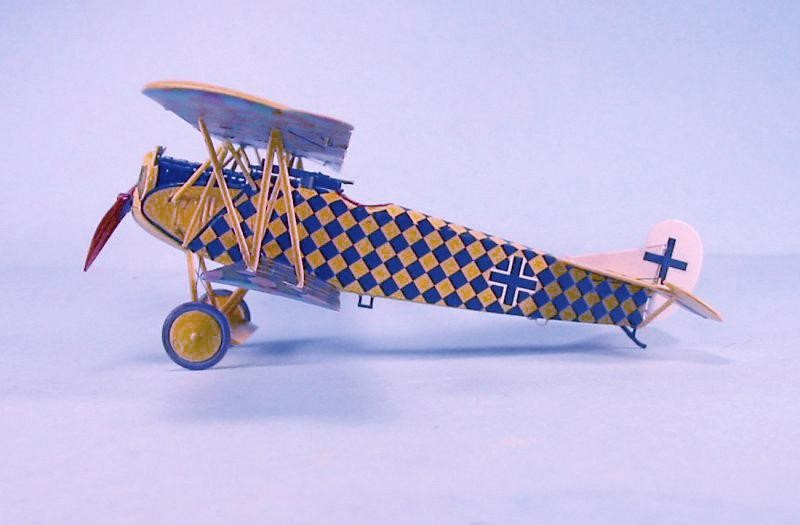
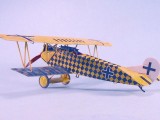

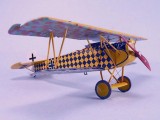
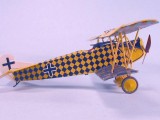
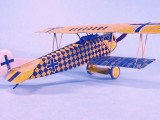
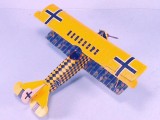
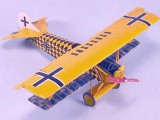
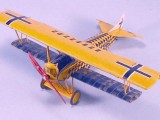
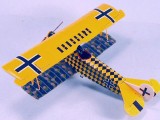
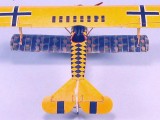
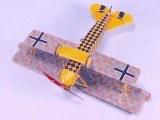
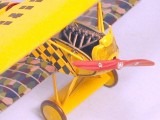
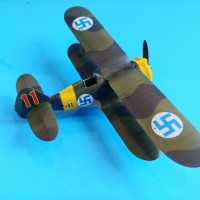
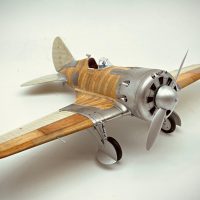
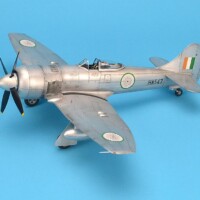
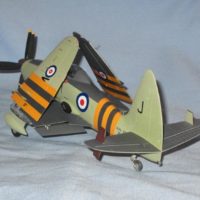
Boy, what a subdued color scheme, like a neon sign!
Did he also fly an E-V in a similar marking?
How did you get that checker pattern? Gotta admire your patience, Tom.
Great work!
He did indeed fly an E.V., as did Osterkamp and others in the Freikorps Sachsenberg. The model was done with decals, past painting it yellow.
Tom, not individually, one checker at a time, I hope? I'm guessing a stencil would be as time consuming.
Decals! Side, top, etc. Lots of concentration.
Tom, my sincere admiration!
Looks like one of the covers of those pulp mags in the 30s, "G-8 and his battle aces". The bad guys always had garish schemes, so you could tell they were the bad guys.
Hope you're resting your eyes after this exercise.
Go have a beer, or two, you've earned it.
beautiful job...1/48 WW1 makes me shutter Gunga Din